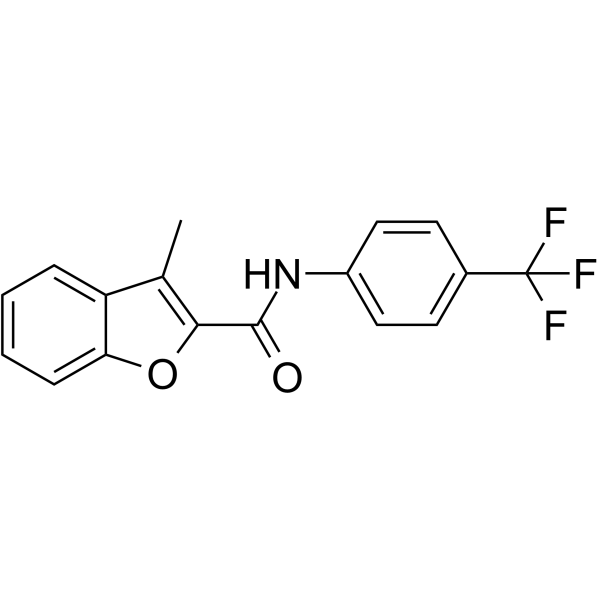588674-64-0
| Name | 3-Methyl-N-[4-(trifluoromethyl)phenyl]-1-benzofuran-2-carboxamide |
|---|---|
| Synonyms |
2-Benzofurancarboxamide, 3-methyl-N-[4-(trifluoromethyl)phenyl]-
3-Methyl-N-[4-(trifluoromethyl)phenyl]-1-benzofuran-2-carboxamide MFCD03943591 |
| Description | CCR6 antagonist 1 is a CCR6 antagonist that inhibits the CCL20/CCR6 axis. CCR6 antagonist 1 can be used in the research of autoimmune-mediated inflammatory diseases, such as inflammatory bowel diseases (IBDs)[1]. |
|---|---|
| Related Catalog | |
| Target |
CCR6 |
| In Vitro | CCR6 antagonist 1 (compound 1b, 50 μM, 3 h) blocks the CCL20-induced CD4+ T cell migration[1]. CCR6 antagonist 1 (30 nM-300 μM, 20 min) inhibits miniGi recruitment to CCR6 induced by CCL20, and β-arrestin-1 recruitment to CCR6 and CCR5 by CCL20 and CCL5 (5 nM), respectively[1]. Cell Migration Assay [1] Cell Line: CCL20 (500 ng/mL)-induced CCR6+CD4+ T cell Concentration: 0.5, 5, 50 μM Incubation Time: 3 h Result: Inhibited CCL20-induced cell migration at 50 μM. |
| In Vivo | CCR6 antagonist 1 (compound 1b, 1 mg/kg, s.c., twice daily for 3 days) alleviates TNBS-induced inflammatory responses in mice[1]. CCR6 antagonist 1 (1 mg/kg, s.c., twice, before and after zymosan treatment) shows anti-inflammatory effects in Zymosan-induced peritonitis mice[1]. Animal Model: Murine model of colitis (5 mg/mouse TNBS-induced)[1] Dosage: 1 mg/kg Administration: Subcutaneous injection (s.c.), twice daily for 3 days. Result: Improved mice general conditions, attenuated macroscopic injury and counteracted neutrophils infiltration, both in the colon and in lungs. Animal Model: Zymosan-induced peritonitis mice[1] Dosage: 1 mg/kg Administration: Subcutaneous injection (s.c.), twice, before and after zymosan treatment Result: Significantly reduced the total protein content and myeloperoxidase activity in the peritoneal lavage. |
| References |
| Density | 1.4±0.1 g/cm3 |
|---|---|
| Boiling Point | 345.9±42.0 °C at 760 mmHg |
| Molecular Formula | C17H12F3NO2 |
| Molecular Weight | 319.278 |
| Flash Point | 163.0±27.9 °C |
| Exact Mass | 319.082001 |
| LogP | 4.18 |
| Vapour Pressure | 0.0±0.8 mmHg at 25°C |
| Index of Refraction | 1.604 |
